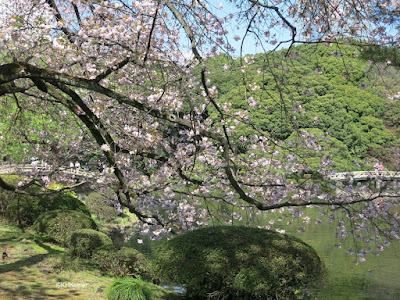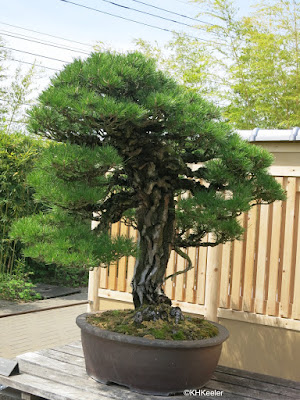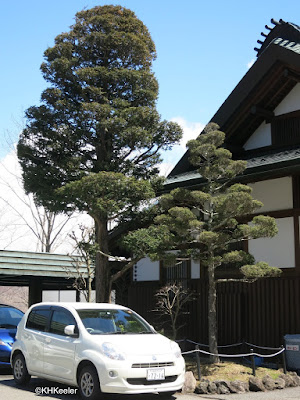 |
| Flowering cherry in Toyko park |
We started in Tokyo, admiring the centuries-old gardens to be found among the skyscrapers.
 |
| Shinjuku Gyoen National Garden, Tokyo |
 |
| (The camellia was put there by someone before me.) |
Very beautiful living works of art.
Seeing the bonsai made me conscious after that of how often the Japanese pruned their trees into graceful shapes. (Look carefully in the first three photos.)
They shaped the trees by their homes,
big old shrubs in a park,
these individual shrubs or small trees, camellias I think, at the edge of an orchard of flowering plums,
 |
| Pruned shrubs, I think they are camellias |
I'm not sure if I like the look or not. Part of my hesitation is my love of wilderness: a perfectly round plant is not a bit natural. On the other hand, some of the pruning imitates and accentuates natural forms.
I liked the look of this tree, from the coast at Matsushima. Natural? Hard to know.
But I also liked this, even though it is clearly pruned
As I write this, I wonder if there are at least two goals in pruning, either to make it "like a beautiful wild plant" as in bonsai, or to make an attractive, balanced shape, whether or not it occurs in nature. Sometimes both can be attained in the same plant, but not always.
 |
| Do you like this look? |
I located my book on pruning and started reading it. I pay a tree service to prune my trees periodically, but the goal is structural soundness, not an artistic shape.
Pruning does appeal to me because successful pruning requires careful understanding of how each plant grows. The act of pruning needs to be thoughtful, almost meditative, since if you make a mess, it will be visible for months if not years. (Been there, done that).
Again, travel makes one see home with new eyes
and think philosophical thoughts about humans and nature. Do we want wild and natural? In the garden? Or carefully arranged and trimmed? Or something else?
Much of Japanese pruning is to make a tree look like the best of wild trees. For example this bonsai:
The product of decades of careful pruning. And stunningly beautful.
Comments and corrections welcome.
Kathy Keeler, A Wandering Botanist
More at awanderingbotanist.com
Join me on Facebook: https://www.facebook.com/AWanderingBotanist









I admire the art of bonsai, although despite my interest in all things plant-related, I've yet to take on the challenge of molding a specimen as such artists do. It's a long term commitment to be sure. However, as you indicated, it does make one look at what's in one's own garden with a different eye.
ReplyDeleteExploring Japan's meticulously pruned trees and shrubs is awe-inspiring! LJR Tree Services Inc
ReplyDelete